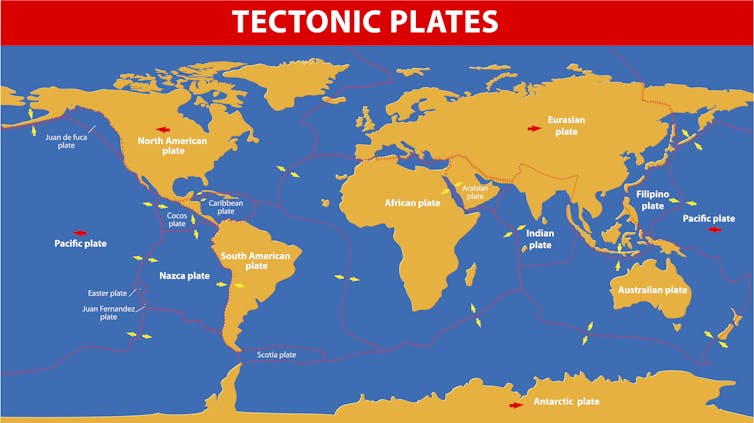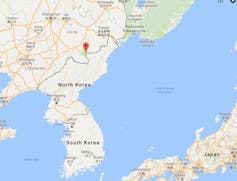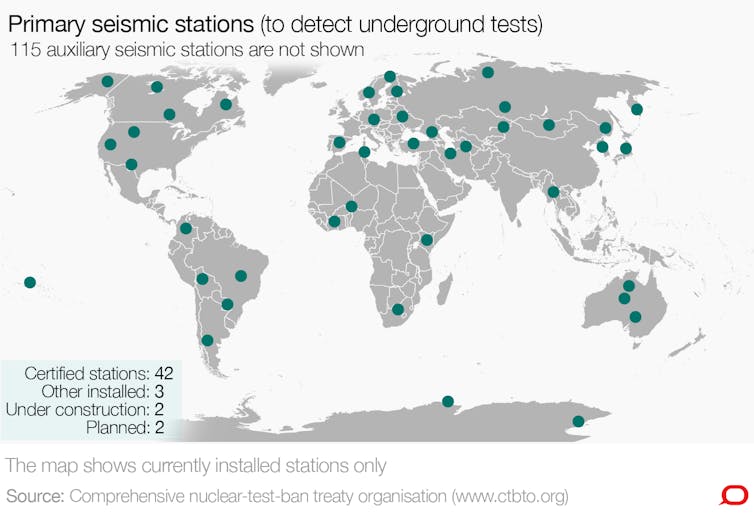I've always wondered: do nuclear tests affect tectonic plates and cause earthquakes or volcanic eruptions?
- Written by Jane Cunneen, Research Fellow, Curtin University
This is an article from I’ve Always Wondered, a new series where readers send in questions they’d like an expert to answer. Send your question to alwayswondered@theconversation.edu.au
Do underground nuclear tests affect Earth’s tectonic plates, and cause earthquakes or volcanic eruptions? - Anne Carroll, Victoria
Apart from escalating global fears about conflict, North Korea’s recent nuclear tests have raised questions about geological events caused by underground explosions.
Some media reports suggest the tests triggered earthquakes in South Korea. Others report the explosions may trigger a volcanic eruption at Paektu Mountain, about 100km from the test site.
So can an underground test cause an earthquake? The short answer is yes: a nuclear explosion can cause small earthquakes. But it is unlikely to affect the earth’s tectonic plates or cause a volcanic eruption.
Although a nuclear explosion releases a lot of energy in the immediate region, the amount of energy is small compared to other stresses on tectonic plates.
Read more: What earthquake science can tell us about North Korea’s nuclear test
What are tectonic plates?
Tectonic plates are slabs of the earth’s crust which move very slowly over the surface of the earth. Mountain ranges form at the edges of the plates when they collide, and ocean basins form when they move apart.
 Tectonic plates are slabs of the earth’s crust.
Designua/shutterstock
Tectonic plates are slabs of the earth’s crust.
Designua/shutterstock
Volcanoes occur mostly where plates are colliding. One plate overrides another, pushing it down to where it may partly melt. The partially melted rock – also known as lava – then rises to the surface, causing a volcano.
The movement of tectonic plates also causes earthquakes, which is why 90% of them occur at the plate boundaries. All but the deepest earthquakes occur along faults, which are breaks in the crust where rocks can move past each other in response to stress. This stress can be from both natural events and human activities.
Human induced earthquakes
“Induced seismicity” is the term used to describe earthquakes caused by human activities.
Human induced earthquakes can be caused by anything that changes the stresses on rocks beneath the surface. These include processes that add or remove great loads from the surface, such as mining, building dams or tall buildings.
Other processes that change the amount of pressure on rocks can include fluid injection from drilling, or extraction of water from aquifers.
Human-induced earthquakes have been reported from every continent except Antarctica. Induced earthquakes only occur where there is already some stress on the rocks. The human activity adds enough stress to the rocks to reach the “tipping point” and trigger the earthquake.
Nuclear explosions can induce small earthquakes along existing faults near a test site. Some underground nuclear tests have fractured the ground surface above the explosions, causing movement on faults adjacent to explosion sites.
Earthquakes from nuclear testing
The 3 September 2017 North Korean nuclear test generated shock waves equivalent to a magnitude 6.3 earthquake. Eight minutes later, a magnitude 4.1 event was detected at the same site. This may have been linked to a collapse of a tunnel related to the blast.
Several small earthquakes measured since the event may have been induced by the nuclear test, but the largest is only a magnitude 3.6. An earthquake of this size would not be felt outside of the immediate area.
Read more: North Korea tests not just a bomb but the global nuclear monitoring system
The largest induced earthquake ever measured from nuclear testing was a magnitude 4.9 in the Soviet Union. An earthquake of this size can cause damage locally but does not affect the full thickness of the earth’s crust. This means it would not have any effect on the movement of tectonic plates.
Historical data from nuclear testing (mostly in the USA) shows that earthquakes associated with nuclear testing typically occur when the explosion itself measures greater than magnitude 5, 10–70 days after the tests, at depths of less than 5km, and closer than around 15km to the explosion site. More recent studies have concluded that nuclear tests are unlikely to induce earthquakes more than about 50km from the test site.
Volcanic eruptions
Concerns have also been raised about the risk of volcanic eruptions induced by the nuclear tests in North Korea. Paektu Mountain is about 100km from the test site and last erupted in 1903.
 Mount Paektu is an active volcano on the border between North Korea and China.
Google Maps
Mount Paektu is an active volcano on the border between North Korea and China.
Google Maps
In the 1970s, the USA conducted a number of nuclear tests in the Aleutian Islands, a volcanic island arc chain containing 62 active volcanoes.
One of the blasts, named Cannikin, was the largest underground nuclear test ever conducted by the USA. There were fears that the blast would cause a huge earthquake and tsunami. The blast did result in some induced earthquakes, but the largest was a magnitude 4.0 and there was no increase in volcanic activity.
Based on this evidence, it seems unlikely a nuclear test by North Korea will trigger an eruption of Paektu Mountain. If the volcano was on the verge of erupting, then an induced earthquake from a nuclear blast could influence the timing of the eruption. However, given the distance from the test site then even this is not likely.
Monitoring nuclear tests
The Comprehensive Nuclear Test Ban Treaty Organisation (CTBTO) has a global monitoring system to detect nuclear tests, including seismometers to measure the shock waves from the blast and other technologies.
 Global network of seismic monitoring stations.
CTBTO / The Conversation, CC BY-NC-ND
Global network of seismic monitoring stations.
CTBTO / The Conversation, CC BY-NC-ND
Seismologists can analyse the seismic data to determine if the shock waves were from a naturally occurring earthquake or a nuclear blast. Shock waves from nuclear blasts have different properties to those from naturally occurring earthquakes.
Testing was much more common before the CTBTO was formed: between 1945 and 1996 more than 2,000 nuclear tests were conducted worldwide, including 1,032 by the USA and 715 by the Soviet Union.
Since 1996 only three countries have tested nuclear devices: India, Pakistan and North Korea. North Korea has conducted six underground nuclear tests at the same site between 2006 and 2017.
Authors: Jane Cunneen, Research Fellow, Curtin University





